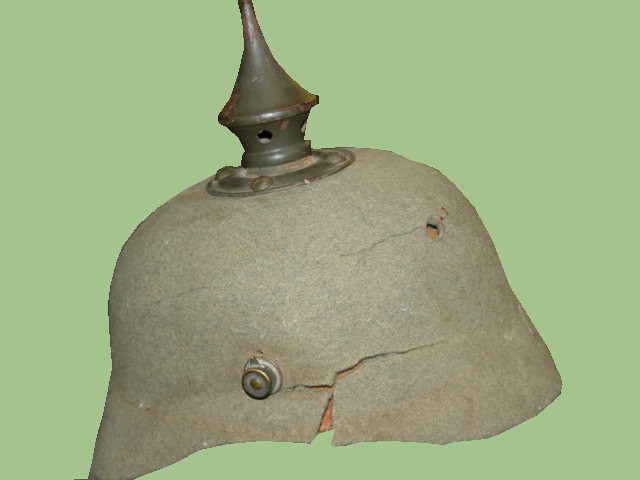WWI German Army Helmet -
This is a German military helmet. As issued during World War One.
The Pickelhaube, from the old German Pickel = "point" or "pickaxe", and Haube = "bonnet", a
general word for headgear, was a spiked helmet worn in the 19th and 20th centuries by German
military, firefighters, and police. It is most closely associated with the Prussian army.
Frederick William IV introduced the Pickelhaube for use by the majority of Prussian infantry on
October 23, 1842 by a royal cabinet order. The use of the Pickelhaube spread rapidly to other
German principalities. Oldenburg adopted it by 1849, Baden by 1870, and in 1887, the Kingdom of
Bavaria was the last German state to adopt the Pickelhaube. During the second half of the 19th
century, the armies of a number of nations besides Russia (including Colombia, Chile, Mexico,
Portugal, Norway, and Sweden) adopted the Pickelhaube or something very similar. The Pickelhaube
also influenced the design of the British army Home Service helmet, as well as the custodian
helmet worn by police in England to this day.

The helmet featured here is a late war production. Of felt construction. The traditional body
would be made of leather, however, as materials became scarce they turned to cheaper options.
The idea did not work very well because felt is not very strong. It tears relatively easily.
It is interesting to note that the pick is a much earlier vintage. More than likely the
helmets were being assembled of spare parts.


|
The modern German helmet saw its birth during World War One. Its design was so advanced
for the time that the German government saw it fit for the same basic design to be re-employed
during World War Two.
The German helmet of World Wat Two has become one of the most recognizable silhouttes of war.
The helmetss of the Third Reich came in a variety of designs. There were approximatelly
9 different types developed. Even the non-military helmets often displayed the
swastika as a means to show support of the Nazi party. The helmet was constructed of a
combination of metal and leather.
|
|




|
WWII German helmets are currently being
reproduced.
It is becoming more difficult to be able to tell the fake ones from the real ones because
the quality of the reproductions is improving. The collector must become familiarized with
the construction style and materials employed in the manufacturing of this headgear.
Attention to the details is critical in order to be able to determine the authenticity of
the collectible.
If you have an interest is seeing other American military headgear, you can do so by
going to our WWII German helmets
identification guide. Where we cover Army, Navy, Luftwaffe and other organizations.
|





